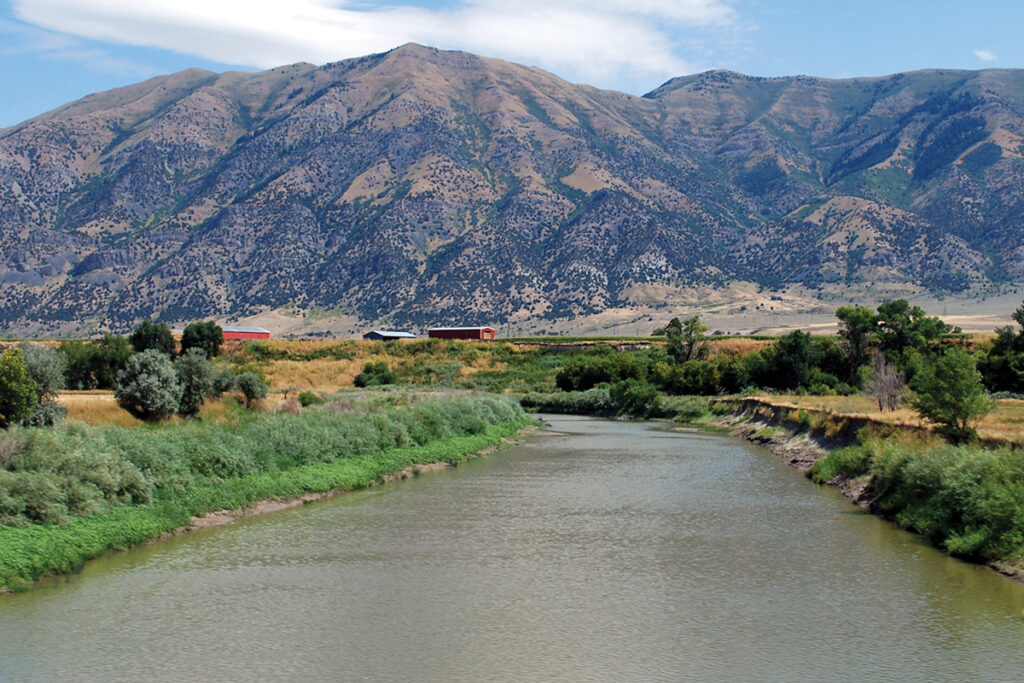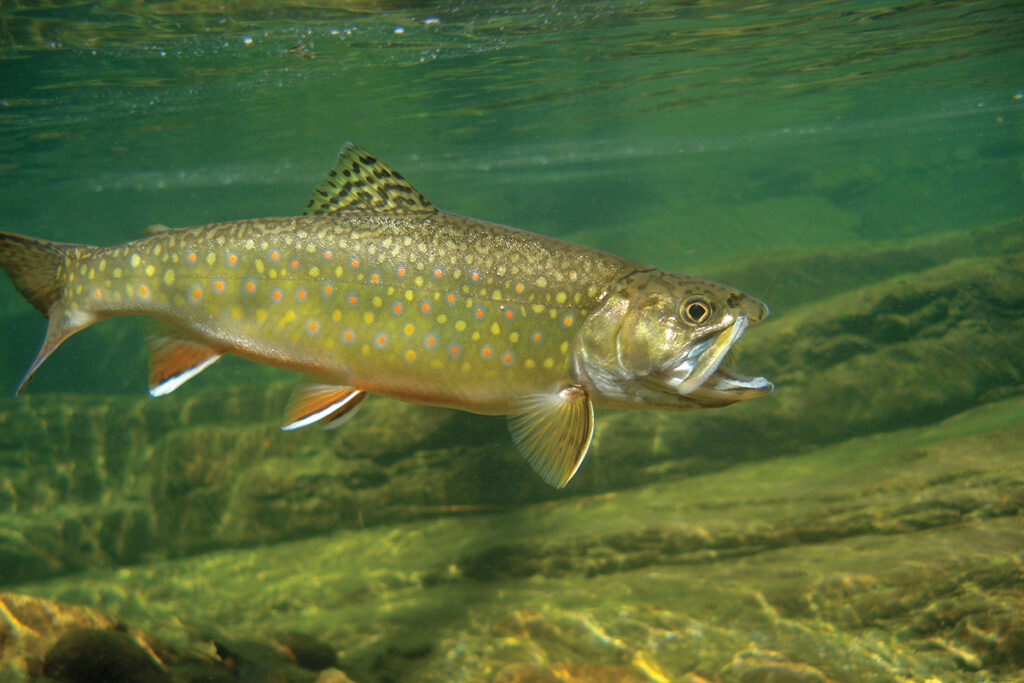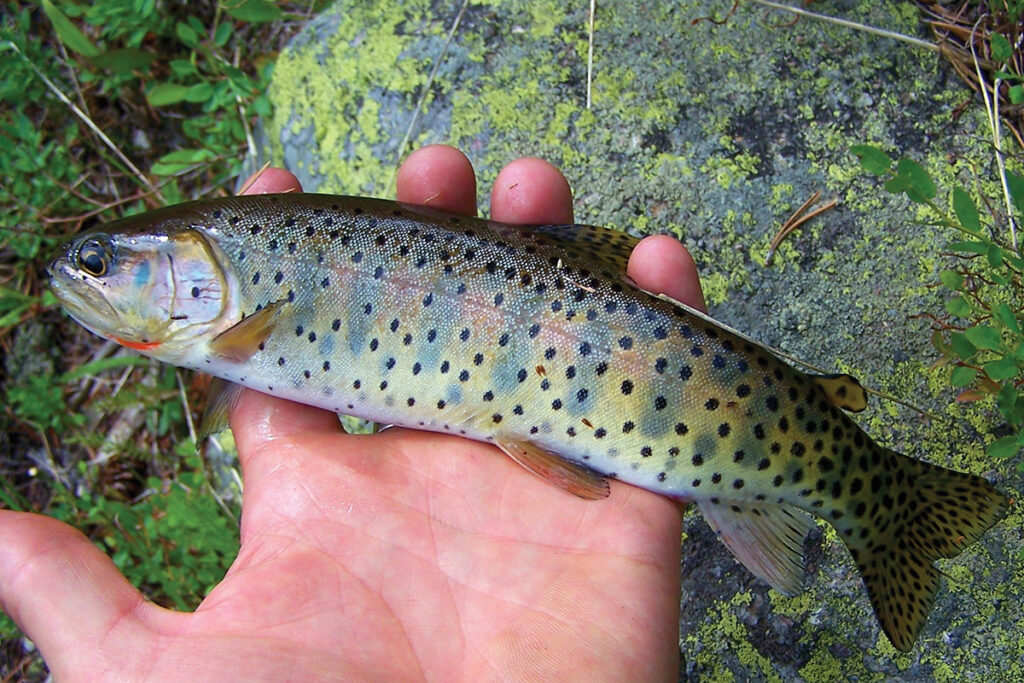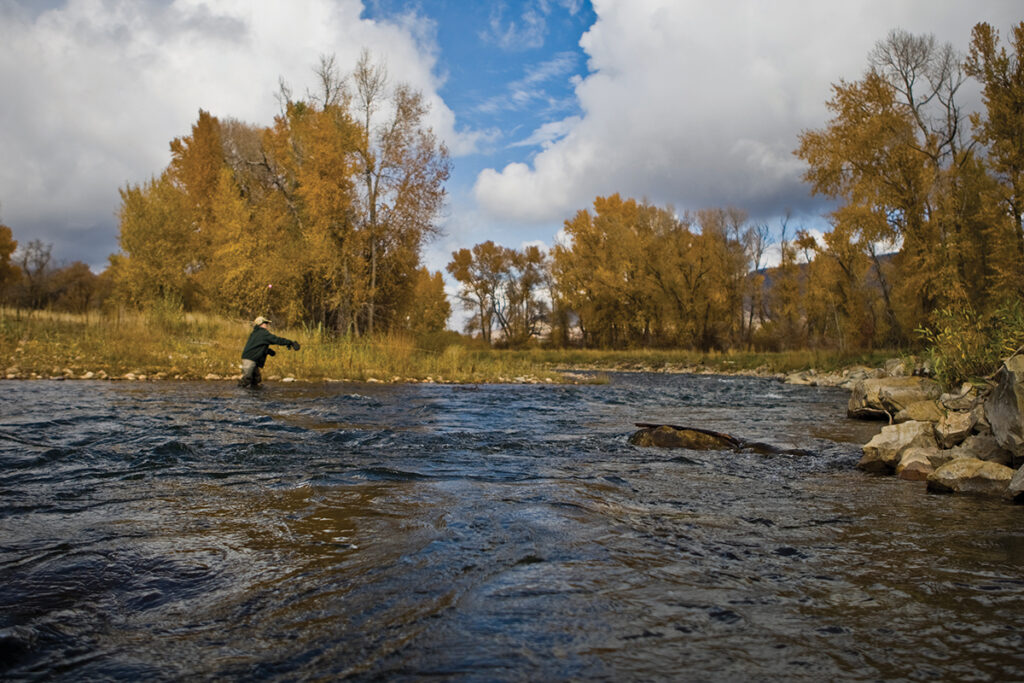This special issue of PERC Reports explores the West’s water crisis and how markets can address today’s shortages. Read the full issue.
In June 2004, my friend and I took a turn around Lafayette Square in Washington, D.C., to commiserate. Both of us had concluded that we weren’t cut out for life at a big law firm, but we didn’t know what to do next. “Here’s your problem,” Mike said to me, “You’re a conservative Republican who wants to save the environment. You’ve got nowhere to go.” He was right. My initial job applications went nowhere. A few came back with what felt like a sympathetic pat on the head: “You seem like an interesting guy. Hope you find something that works out.”
In the end, however, I took Mike’s advice to explore “hook and bullet” organizations, eventually landing a job with Trout Unlimited in my home state of Utah. The job paid little, but the mission intrigued me: reform Utah water law to make it easier for conservationists to protect habitat for trout by leasing water from farmers.
Seemed simple enough to a policy hack like me: Why shouldn’t Trout Unlimited be able to pay a farmer to leave a little water in the stream? What I failed to grasp at the time was the accumulated weight of the prior appropriation doctrine, the legal framework that underpins western water law. The doctrine allocates water rights based on who first diverted water and put it to “beneficial use,” a term that historically included water for consumptive use in farms, homes, and industry, but not habitat for fish and wildlife. In the eyes of the prior appropriation doctrine, water left instream hasn’t been put to beneficial use, and it is therefore “wasted” and available to satisfy any new or existing consumptive water right.
The job paid little, but the mission intrigued me: reform Utah water law to make it easier for conservationists to protect habitat for trout by leasing water from farmers
While Utah law modified the doctrine to recognize the value of water left instream as far back as the early 1980s, it allowed only two state agencies—the Divisions of Wildlife Resources and State Parks—to acquire and hold instream rights, and that authority had seldom been used. To my mind, extending that right to a private entity made for an easy sell to a legislature dominated by conservative Republicans who mistrust government: If the state could be trusted to hold such rights, why not private actors?
If the theory seemed easy, the application proved hard. A colleague had once shown a photo of a dry stream to a group of farmers to illustrate the problem we were trying to solve. They cheered—not for our proposal, but for the dry stream bed, a “fully allocated” system.
My own initial efforts fared little better. In debates over relicensing a hydroelectric project in which we hoped to secure a modest instream flow to mitigate environmental harms, I told an irrigator that the babble of a small stream in the high desert was a “hymn to all Creation” that we shouldn’t silence. In response, he told me, in so many words, to go to Hell. My initial efforts to lobby the legislature were met with similar welcome. I crafted a one-paragraph amendment to existing law that would have allowed private entities to lease water for instream flows on a temporary basis. No one showed much interest. Many said we should work through existing law. One person told me bluntly that changing the law to allow private leasing would prove “impossible.”
Cracks in the Wall
One day, after another setback, I expressed frustration to a well-respected water lawyer. “But this will benefit agriculture!” I protested. “Tim,” he said, “They don’t know you, so they don’t trust you.” I let that sink in. Not long after, I invited members of the Utah Farm Bureau to take a trip with me to Montana where they could meet farmers and ranchers who had real-world experience with private leases for instream flows. I figured Utah ranchers would trust Montana ranchers more than a city slicker like me, and they did. But the trip also helped build lasting relationships with the Farm Bureau, which opened the door to real conversations about private leasing, the opportunities it could provide to agricultural producers, and potential safeguards that we could build into legislation.

To address concerns, I began adding restrictions to the draft bill. The idea was this: We needed proof of concept—to show that the sky wouldn’t fall if Utah allowed private leasing on a limited basis. As long as we could demonstrate the concept, we could live with all kinds of restrictions. Soon the draft included a 10-year sunset, a 10-year time limit on leases, restrictions on how far downstream protected flows could go, loss of seniority for leased instream rights, restrictions on who could hold the rights (only “private fishing groups”), and more.
The day of the first legislative hearing arrived. By then I’d refined my talking points down to three central principles: private property rights, free enterprise, and limited government. My presentation included a photo of Karl Marx, with a quote from Marx about how the government alone should control the means of production. I reasoned that defenders of the status quo wouldn’t want to align themselves with Karl Marx, and I was right. The workgroup recommended the bill favorably.
Stuffed at the Goal Line
Over three years, the bill, now called “Instream Flows to Protect Trout Habitat,” had ballooned from a few sentences to more than 400 lines. Along with all of that weight, however, it now had positive momentum. Significantly, the Utah Farm Bureau took a position of support. After being introduced in the 2007 legislative session, a Senate committee unanimously approved the bill, after which the chair said to me: “You know I’ve struggled with this one, but my father owns a ranch on the Bear River, and he’s been working with Warren Colyer of Trout Unlimited on a restoration project on his ranch. Warren has done everything he said he’d do, so I think you guys deserve a chance.”
Progress always stalled higher up in the bureaucracy. Every time I thought we’d made progress and advanced to the next level, someone would say, “Wait, you mean fish could die?” ignoring the species-wide conservation benefits.
The bill sailed through the Senate, and my confidence grew. It hit a rough patch in the House, however, where it barely passed committee by a vote of 7-6. The key detractor was Rep. Mike Noel, from southern Utah, who feared that a water user who entered into a voluntary agreement with Trout Unlimited could be forced by the federal government to keep water instream if the trout species benefited by the lease were later listed under the Endangered Species Act. In other words, he feared that a voluntary lease could be converted into an involuntary one through application of federal law. It seemed like a remote risk, and the U.S. Fish and Wildlife Service reassured me that they’d never do such a thing, so we decided to press forward rather than craft a difficult amendment for the House floor.
After rigorous debate, the bill drew 36 “yes” votes and 32 “no” votes, with seven absent. In Utah a bill requires 38 votes to pass, and so “Instream Flows to Protect Trout Habitat,” after three years of blood, sweat, and tears, failed by a mere two votes. In a private meeting with a few legislators afterwards, I broke down in tears. I couldn’t believe we’d come so close.
If at First You Don’t Succeed
The setback stung, but we had reasons for optimism. The concept now had strong support from many quarters, and opposition in the House was driven largely by one person with a specific concern that felt solvable. So I went to work solving it. As it turned out, the representative’s concerns weren’t entirely unfounded. There was a possibility that a voluntary lease could become an involuntary one under the worst-case scenario he described.

A potential solution soon took shape: something called a Candidate Conservation Agreement with Assurances (CCAA) with the U.S. Fish and Wildlife Service, which operates like a safe harbor agreement for species at risk for listing under the Endangered Species Act. In this case, an instream flow lease to benefit one of Utah’s four species of native trout would offer species-level benefits in the form of expanded habitat. Because such leases are temporary and voluntary, however, individual leases could eventually terminate, affecting habitat and, potentially, killing some fish. The CCAA would shield participants in the leasing program from punitive measures if the Fish and Wildlife Service later decided to list the trout species that the lease protected.
I traveled to southern Utah to meet with Rep. Noel, explained the idea, and he agreed to support the bill if it required a CCAA be in place before leasing could occur. We added that requirement, and in 2008, with support from Rep. Noel and little opposition, the bill sailed through the House with unanimous support. That momentum carried over in the Senate, where the bill passed easily and was signed into law.
The Devil in the Details
At long last, Utah law now allowed a private entity to hold instream flow rights, at least in theory. While we had the statutory authorization, we did not have a CCAA in place. Biologists from the Fish and Wildlife Service grasped the concept and did their best to help, but progress always stalled higher up in the bureaucracy. Every time I thought we’d made progress and advanced to the next level, someone would say, “Wait, you mean fish could die?” ignoring the species-wide conservation benefits. I repeatedly explained it this way: “Let’s say that the leasing program creates habitat for an additional 50,000 fish. If a lease terminates and we lose 500 fish, we’re still 49,950 fish ahead, right?” Wrong, apparently. After years of trying, we failed to secure a CCAA, which meant that we had no opportunity to actually use the new legislative authority.
Ultimately, I concluded that it would be easier to change Utah water law again than to navigate the federal bureaucracy. So, in 2013, a full five years after passage of the original bill, the Utah legislature unanimously passed a bill amending the original instream flow law, with none other than Rep. Mike Noel as the principal sponsor. The solution to the CCAA problem? Create a second path, whereby, absent a CCAA, a lease could go forward provided the lessee agreed in the contract to assume any Endangered Species Act liability and protect the owner of the water right against that risk.

Finally, Trout Unlimited was free to pursue private leases, and, over the next five years, did just that, securing several modest leases around the state. The sky did not fall. The farmers who participated benefited either through lease payments or other in-kind benefits such as the installation of irrigation pivots or other labor-saving technologies. In short, the proof of concept effort delivered as promised.
In 2015, I was elected to the Utah House of Representatives, which put me in a position, in 2019, to introduce another bill that removed the 10-year sunset on the private leasing program, making it permanent. The Utah Farm Bureau, now a trusted partner, again spoke in favor. The bill passed unanimously.
Kicking Open the Door
If the 2008 legislation opened the door for private leasing, it opened it just a crack. Over time the restrictive nature of the legislation became clear, not just to Trout Unlimited, but also to the State Engineer’s Office, which had to help parties navigate the law’s many obstacles. The restrictions also frustrated farmers, some of whom wanted to participate but could not on account of the many restrictions.
With a lot of time, effort, and engagement by many stakeholders over several years, Utah law now provides significant tools to protect water in our rivers, lakes, and streams.
In 2019, Utah State Engineer Teresa Wilhelmsen suggested to a group of stakeholders that the legislature tweak the instream flow program to make it easier to use and administer. By that time, at least three strong supporters of private leasing were serving in the Utah House: myself, Rep. Joel Ferry, and Rep. Casey Snider. The three of us decided that, if we were going to go to the trouble to modify the statute, we shouldn’t just tune up an what amounted to an old kid’s bike with “20 training wheels dangling off of it,” but rather take off all the training wheels, scale up the size, and let it run like a proper bicycle.
That line of thinking ushered in House Bill 33, a significant policy shift that rolled through the legislature with minimal opposition in 2022. The bill’s principal sponsor was Rep. Ferry, a full-time farmer and rancher and an early advocate of private leasing for its potential to benefit agricultural producers. The Senate sponsor was Scott Sandall, another full-time farmer and rancher. While some in the agricultural community expressed concerns about the scale of the changes, that opposition carried little weight in the face of broad support in the water community and leadership from two senior Republican legislators who make their livelihoods in agriculture.

What does that bill do? It 1) allows any private person or entity to lease water for instream flows; 2) allows a water right holder to convert an existing right to an instream flow on a temporary basis without involving any other party; 3) allows the Division of Forestry, Fire, and State Lands to acquire and hold instream flow rights to benefit state sovereign lands, including the Great Salt Lake; and 4) removes the CCAA requirement and many other restrictions. In short, it treats instream flows like more traditional, consumptive rights, and it reflects a fully mature policy response—16 years in the making.
Lessons Learned
My hard-won experience pursuing instream flow reform in Utah taught me many valuable lessons that could be applied by those trying to promote leasing and other free-market environmental reforms elsewhere.
- One cannot change deeply rooted institutions such as western water law on the cheap or on the fly. It requires time, patience, and sustained effort. Earning trust takes time. It also requires playing it straight with stakeholders and living up to commitments.
- Solving complex challenges requires extensive engagement with those most affected. In most states that means working with—not against—the agricultural community. It also requires spending significant time on the ground in rural areas and genuinely understanding rural concerns.
- Identify the most credible voices and engage them early on. Too many advocates engage only allies or start with the media, which risks backlash if the media frames the issue in unhelpful ways.
- Lasting solutions must do more than pay lip service to the idea of win-win. Solutions that don’t work for major stakeholders don’t work at all because resistance will only grow over time. On the other hand, support for genuine win-win solutions grows as stakeholders see and recognize the program’s value. That paves the way for bigger successes later.
- Pay attention to transaction costs. Expensive or difficult-to-use legal tools have little value because no one will use them. Don’t build into legislation requirements—like the CCAA—that turn on federal actors or other remote decision makers.
- Pilot programs help reassure policymakers and other stakeholders because they allow a window to test proof of concept without making permanent changes to long-standing law.
- Get to know the political landscape. Advocates for the environment tend to gravitate to left-leaning legislators who represent urban districts. In a state like Utah, that’s a recipe for disaster. Winning over opponents carries far more value than preaching to the already converted.
What’s Next?
With a lot of time, effort, and engagement by many stakeholders over several years, Utah law now provides significant tools to protect water in our rivers, lakes, and streams. The challenge now lies less in the legal framework than in the implementation. How do we deploy these new tools? How do we make them work in ways that share scarce water resources between competing uses? How do we fund innovations that will help during times of scarcity? While those challenges remain daunting, the good news is this: In Utah, we can and will solve them by working together.




